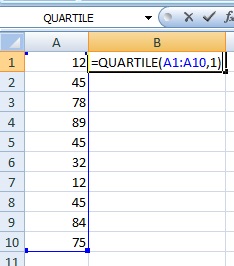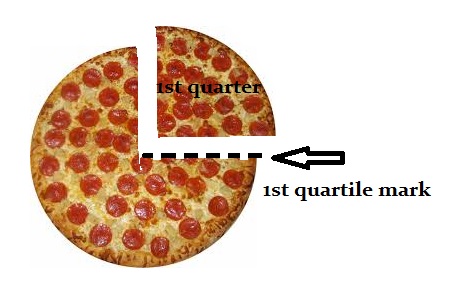How To Find The Quartiles Of A Data Set
Contents:
- Quartiles: Definition, Finding
- What is an Upper Quartile?
- Quartile Function Excel
- Deviation between a quarter and a quartile
What are Quartiles? Definition
Watch the video for an overview of quartiles:
Can't run into the video? Click here.
Quartiles are values that divide your data into quarters. Nonetheless, quartiles aren't shaped similar pizza slices; Instead they divide your information into four segments according to where the numbers fall on the number line. The four quarters that divide a data set into quartiles are:
- The lowest 25% of numbers.
- The adjacent lowest 25% of numbers (upwards to the median).
- The second highest 25% of numbers (above the median).
- The highest 25% of numbers.

Every bit quartiles divide numbers up according to where their position is on the number line, you have to put the numbers in social club before you lot can figure out where the quartiles are.
Observe Quartiles: Examples
Demand help with a homework question? Bank check out our tutoring page!
Example: Split the following data set into quartiles: 2, 5, vi, 7, 10, 22, xiii, 14, 16, 65, 45, 12.
Footstep 1: Put the numbers in order: 2, 5, 6, vii, 10, 12 13, 14, 16, 22, 45, 65.
Step ii: Count how many numbers at that place are in your set and then separate by 4 to cut the listing of numbers into quarters. At that place are 12 numbers in this set, and then you would accept iii numbers in each quartile.
ii, 5, six, | 7, 10, 12 | 13, 14, 16, | 22, 45, 65
If you have an uneven set of numbers, information technology's OK to slice a number down the middle. This tin can get a little tricky (imagine trying to separate 10, thirteen, 17, nineteen, 21 into quarters!), then yous may want to use an online interquartile range calculator to effigy those quartiles out for you. The figurer gives you the 25th Percentile, which is the cease of the start quartile, the 50th Percentile which is the end of the 2d quartile (or the median) and the 75th Percentile, which is the cease of the third quartile. For 10, thirteen, 17, 19 and 21 the results are:
25th Percentile: 11.5
50th Percentile: 17
75th Percentile: twenty
Interquartile Range: 8.5.
Why do we demand quartiles in statistics? The main reason is to perform further calculations, like the interquartile range, which is a measure of how the information is spread out around the mean.
What is an Upper Quartile?
The upper quartile (sometimes called Q3) is the number dividing the third and quaternary quartile. The upper quartile can also be idea of equally the median of the upper one-half of the numbers. The upper quartile is also called the 75th percentile; information technology splits the everyman 75% of data from the highest 25%.
![]()
A set up of numbers (-3,-2,-1,0,1,2,three) divided into four quartiles.
Computing the Upper Quartile
You tin find the upper quartile past placing a gear up of numbers in order and working out Q3 by hand, or you tin employ the upper quartile formula. If you accept a modest fix of numbers (under nigh xx), by hand is usually the easiest selection. However, the formula works for all sets of numbers, from very small to very large. Yous may also want to use the formula if you are uncomfortable with finding the median for sets of data with odd or fifty-fifty numbers.
27, 19, 5, 7, half-dozen, 9, xv, 12, eighteen, two, 1.
By Hand
Step 1: Put your numbers in guild: 1, 2, 5, six, 7, 9, 12, xv, 18, 19, 27
Step 2: Detect the median: 1, two, 5, 6, 7, 9, 12, 15, 18, 19, 27.
Step three: Identify parentheses effectually the numbers above the median.
one, two, 5, six, 7, 9, (12, 15, xviii, xix, 27).
Footstep 4: Notice the median of the upper gear up of numbers. This is the upper quartile:
1, two, 5, vi, 7, nine, (12, 15, 18 ,19 ,27).
Using the Formula
The upper quartile formula is:
Qiii = ¾(n + 1)thursday Term.
The formula doesn't requite you lot the value for the upper quartile, information technology gives yous the place. For example, the 5th identify, or the 76th place.
Step one: Put your numbers in lodge: one, 2, 5, 6, seven, nine, 12, 15, eighteen, nineteen, 27.
Note: for very large data sets, you may want to utilize Excel to place your numbers in order. See: Sorting Numbers in Excel.
Step two: Piece of work the formula. At that place are 11 numbers in the gear up, so:
Qthree = ¾(n + i)th Term.
Q3 = ¾(11 + ane)th Term.
Q3 = ¾(12)th Term.
Qiii = 9th Term.
In this set of numbers (1, 2, five, 6, 7, ix, 12, xv, 18, 19, 27), the upper quartile (18) is the 9th term, or the 9th place from the left.
Quartile Function Excel
Yous can also find a quartile in Microsoft Excel using the Excel quartile function.
- Type your data into a single column. For example, type your data into cells A1 to A10.
- Click an empty cell somewhere on the sheet. For example, click jail cell B1.
- Type "=QUARTILE(A1:A10,1)" then press "Enter". This finds the first quartile. To observe the tertiary quartile, type "=QUARTILE(A1:A10,3)".
Notation: If your data is in a dissimilar cell range other than A1:A10, brand sure you change the role to reflect that.

Difference between a quarter and a quartile
At that place's a slight departure between a quarter and quartile. A quarter is the whole slice of pizza, simply a quartile is the mark the pizza cutter makes at the stop of the slice.

A quarter of the pizza is the whole slice; a quartile marks the end of the first quarter and the beginning of the second.
References
Gonick, Fifty. (1993). The Cartoon Guide to Statistics. HarperPerennial.
Kotz, South.; et al., eds. (2006), Encyclopedia of Statistical Sciences, Wiley.
Lindstrom, D. (2010). Schaum'southward Easy Outline of Statistics, Second Edition (Schaum's Easy Outlines) 2nd Edition. McGraw-Hill Pedagogy
---------------------------------------------------------------------------
Need help with a homework or exam question? With Chegg Study, you can get stride-by-step solutions to your questions from an expert in the field. Your first thirty minutes with a Chegg tutor is complimentary!
Comments? Need to post a correction? Please post a comment on our Facebook page .
How To Find The Quartiles Of A Data Set,
Source: https://www.statisticshowto.com/probability-and-statistics/statistics-definitions/what-are-quartiles/
Posted by: mcconnellthentell.blogspot.com


0 Response to "How To Find The Quartiles Of A Data Set"
Post a Comment